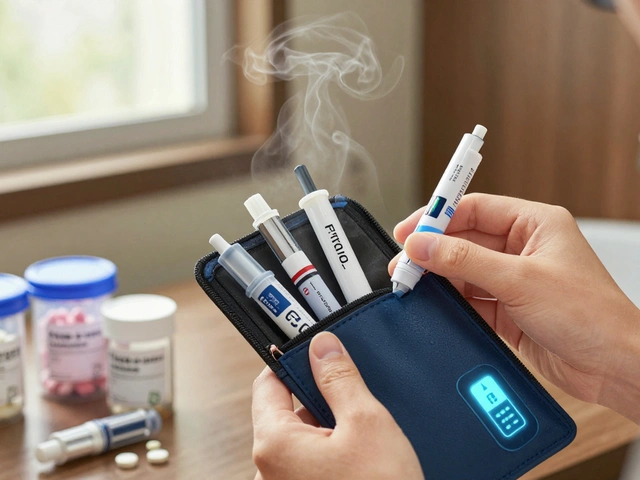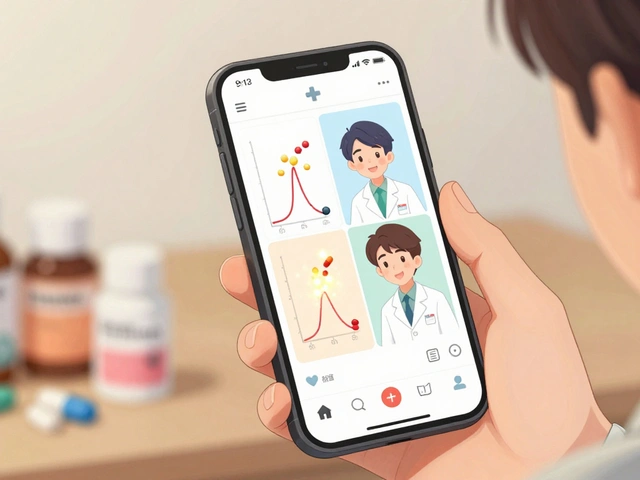Blood Pressure Medication Comparison Tool
Find Your Best Blood Pressure Medication Alternative
Answer a few simple questions to see which medications might work best for you compared to Micardis (Telmisartan).
High blood pressure doesn’t care how busy you are, how much you exercise, or how healthy you eat. If your doctor prescribed Micardis (telmisartan), you’re probably wondering: is this really the best option? Or are there better, cheaper, or safer alternatives? You’re not alone. Many people on telmisartan start asking these questions after a few months-especially when they see side effects, notice their blood pressure isn’t dropping as expected, or get hit with a big pharmacy bill.
What Micardis (Telmisartan) Actually Does
Micardis is the brand name for telmisartan, an ARB-angiotensin II receptor blocker. It works by blocking a hormone called angiotensin II, which normally tightens blood vessels. When that hormone can’t do its job, your vessels relax, and your blood pressure drops. Unlike some other blood pressure pills, telmisartan also has a long half-life, meaning it stays active in your body for over 24 hours. That’s why most people only need one pill a day.
It’s not just about lowering numbers. Studies show telmisartan can reduce the risk of heart attack and stroke in people with high blood pressure and other risk factors like diabetes. The ONTARGET trial, which followed over 25,000 patients, found telmisartan was just as effective as lisinopril (an ACE inhibitor) at preventing cardiovascular events-but with fewer side effects like cough.
Why People Look for Alternatives
People switch from Micardis for a few clear reasons:
- Cost: Brand-name Micardis can cost $120-$180 a month in Australia without a subsidy. Generic telmisartan is cheaper, but still more expensive than some other ARBs.
- Side effects: Dizziness, back pain, and high potassium levels are common. Some people get a weird, persistent cough-though less often than with ACE inhibitors.
- Not working well enough: About 30% of people need more than one drug to get their blood pressure under control. If telmisartan alone isn’t cutting it, your doctor might add or swap in something else.
- Other health conditions: If you have kidney disease, heart failure, or diabetes, some alternatives might be more protective.
Top Alternatives to Micardis (Telmisartan)
There are four main classes of blood pressure drugs that are commonly used as alternatives to telmisartan. Each has pros and cons.
1. Losartan (Cozaar)
Losartan is another ARB, just like telmisartan. It’s been around longer and is available as a cheap generic. In head-to-head trials, losartan lowers blood pressure slightly less than telmisartan-by about 3-5 mmHg systolic on average. But for many people, that difference doesn’t matter. Losartan is often the first switch doctors recommend because it’s affordable and well-studied.
One key advantage: losartan has been shown to reduce protein in the urine (a sign of kidney damage) in people with diabetes. If you have diabetic kidney disease, losartan might be the better pick.
2. Valsartan (Diovan)
Valsartan is another ARB that’s been used for over 20 years. It’s similar in strength to telmisartan but has a shorter duration of action. That means some people need to take it twice a day, which can be a hassle. The newer combination pills (like Diovan HCT) combine valsartan with a diuretic, which can be helpful if you’re retaining fluid.
Studies like VALIANT showed valsartan reduces death after a heart attack. If you’ve had a heart attack and your blood pressure is still high, valsartan might be preferred.
3. Lisinopril (Zestril, Prinivil)
Lisinopril is an ACE inhibitor, not an ARB. It works similarly to telmisartan but blocks a different step in the same pathway. It’s one of the cheapest blood pressure pills in Australia-often under $5 a month with a PBS subsidy.
But here’s the catch: about 10-20% of people on ACE inhibitors get a dry, hacking cough. It’s not dangerous, but it’s annoying enough that many stop taking it. If you’ve had a cough on lisinopril before, avoid switching back. Also, ACE inhibitors can raise potassium levels more than ARBs, so if you have kidney issues, your doctor will monitor you closely.
4. Amlodipine (Norvasc)
Amlodipine is a calcium channel blocker. It works completely differently-by relaxing the muscles in your artery walls. It’s often used as a first-line drug, especially in older adults or people of African or Caribbean descent, who tend to respond better to calcium channel blockers than to ARBs or ACE inhibitors.
It doesn’t cause cough or raise potassium. But it can cause swollen ankles, flushing, or dizziness. Many doctors combine amlodipine with an ARB like telmisartan if one drug alone isn’t enough. In fact, combination pills like Twynsta (amlodipine + telmisartan) exist for exactly this reason.

Comparison Table: Micardis vs. Common Alternatives
| Medication | Class | Typical Daily Dose | Cost (AUD, generic, 30-day) | Key Pros | Key Cons |
|---|---|---|---|---|---|
| Telmisartan (Micardis) | ARB | 40-80 mg | $30-$60 | 24-hour coverage, good for diabetes, low cough risk | More expensive than other ARBs, can raise potassium |
| Losartan | ARB | 50-100 mg | $10-$20 | Very cheap, protects kidneys in diabetics | Shorter action, may need twice-daily dosing |
| Valsartan | ARB | 80-160 mg | $20-$40 | Proven after heart attack, good combo options | Often needs twice-daily dosing |
| Lisinopril | ACE inhibitor | 10-40 mg | $5-$15 | Lowest cost, strong evidence for heart protection | Cough in 10-20% of users, higher potassium risk |
| Amlodipine | Calcium channel blocker | 5-10 mg | $10-$25 | Works well in older adults, no cough, good for African descent | Swollen ankles, flushing, dizziness |
When to Stick With Micardis
You should keep telmisartan if:
- Your blood pressure is under control (below 130/80 mmHg)
- You don’t have side effects like dizziness or high potassium
- You have type 2 diabetes and need kidney protection
- You tried an ACE inhibitor and got a cough
Telmisartan is one of the most effective ARBs for long-term blood pressure control. If it’s working and you’re tolerating it, there’s no need to switch just to save a few dollars. The goal isn’t the cheapest pill-it’s the one that keeps you healthy and out of the hospital.
When to Consider Switching
Switch if:
- Your blood pressure is still high (above 140/90 mmHg) on the maximum dose
- You’re spending over $50/month on generic telmisartan and can’t afford it
- You’re experiencing swelling, dizziness, or fatigue that might be drug-related
- You have heart failure or had a recent heart attack-valsartan or lisinopril might be better
- You’re over 65 or of African descent-amlodipine might work better
Don’t switch on your own. Talk to your doctor. Sometimes, adding a low-dose diuretic like hydrochlorothiazide (HCTZ) to your current regimen works better than swapping drugs entirely.

What About Natural Alternatives?
Some people look to magnesium, potassium, garlic, or beetroot juice to lower blood pressure naturally. While these can help a little-maybe 5-10 mmHg-they’re not replacements for medication. If your blood pressure is 160/100, no amount of celery juice will bring it down safely. Natural options work best as extras, not substitutes.
Also, don’t take potassium supplements unless your doctor tells you to. High potassium levels can cause dangerous heart rhythms, especially if you’re on ARBs or ACE inhibitors.
What Your Doctor Will Consider Before Switching
Your doctor doesn’t just look at your blood pressure number. They’ll check:
- How your kidneys are doing (creatinine, eGFR)
- Your potassium levels
- If you have diabetes, heart failure, or chronic kidney disease
- Your age and ethnicity
- What other meds you’re taking (like NSAIDs or lithium)
- Your insurance or PBS coverage
In Australia, the Pharmaceutical Benefits Scheme (PBS) subsidizes most of these drugs. Telmisartan, losartan, and lisinopril are all on the PBS. Amlodipine is too. So cost differences are often small after subsidy. The real issue is which drug fits your body and lifestyle.
What to Do Next
If you’re thinking about switching from Micardis:
- Write down your concerns: Is it cost? Side effects? Blood pressure still high?
- Check your last blood test results-especially potassium and kidney function.
- Ask your doctor: "Is there a cheaper or better option for me?" Don’t be afraid to ask about generic versions.
- If switching, give the new drug at least 4-6 weeks to work. Blood pressure meds don’t kick in overnight.
- Monitor your blood pressure at home. Bring the readings to your next appointment.
There’s no single "best" blood pressure pill. The right one is the one that works for you-without side effects, without breaking the bank, and without making you feel worse.
Is telmisartan better than losartan for blood pressure?
Telmisartan lowers blood pressure slightly more than losartan-by about 3-5 mmHg on average. But for most people, that small difference doesn’t change their risk of stroke or heart attack. Losartan is much cheaper and has strong evidence for protecting kidneys in diabetics. So if you have diabetes, losartan might be the better choice. If cost isn’t an issue and you need the strongest ARB, telmisartan has a slight edge.
Can I switch from Micardis to lisinopril if I get a cough?
No. If you got a cough on lisinopril before, switching back will likely bring it back. That cough is caused by the ACE inhibitor class, not the specific drug. Telmisartan is an ARB, which doesn’t cause that cough. If you need to switch away from telmisartan, choose another ARB like losartan or valsartan, or a calcium channel blocker like amlodipine.
Is generic telmisartan as good as Micardis?
Yes. Generic telmisartan contains the exact same active ingredient as Micardis. The FDA and TGA require generics to be bioequivalent-meaning they work the same way in your body. The only differences are in inactive ingredients (like fillers), which rarely affect how the drug works. Most people do just as well on generic telmisartan. The brand name costs more, but offers no clinical advantage.
What’s the safest blood pressure medicine for seniors?
For older adults, calcium channel blockers like amlodipine are often preferred because they’re effective, don’t cause cough or high potassium, and work well in people of African or Caribbean descent. ARBs like telmisartan are also safe and often used, especially if the person has diabetes or kidney disease. The key is avoiding drugs that cause dizziness or low blood pressure, which can lead to falls. Always start low and go slow.
Can I stop Micardis if my blood pressure is normal?
No-not without talking to your doctor. High blood pressure is usually a lifelong condition. Stopping the medication-even if your numbers are normal-can cause your pressure to spike back up, sometimes dangerously. Normal readings mean the drug is working. If you want to reduce or stop it, your doctor might suggest lifestyle changes first, then slowly lower the dose under supervision. Never stop cold turkey.





Leslie Schnack
November 1, 2025 AT 05:17I switched from Micardis to losartan last year after my pharmacy bill hit $150/month. My BP stayed the same, and I saved $100 a month. Honestly, I didn’t notice any difference in how I felt-just less stress about money. Generic is legit.
Also, my doc didn’t even mention the kidney protection thing with losartan until I asked. Glad I dug into it.
Saumyata Tiwari
November 2, 2025 AT 10:24How can Americans even complain about $60 for telmisartan? In India, we pay less than $2 for the same generic-and it’s just as effective. You people treat medicine like a luxury brand. Get a grip. Your healthcare system is broken, not the medication.
Also, ‘natural alternatives’? Please. If you need a pill, take the pill. Beet juice won’t save you from a stroke.
Anthony Tong
November 4, 2025 AT 00:05Let’s be clear: the FDA and TGA’s ‘bioequivalence’ standards are a joke. They allow generics to vary by up to 20% in absorption. That’s not ‘the same drug’-that’s a gamble.
And don’t get me started on the PBS subsidy. It’s not charity-it’s state control disguised as affordability. Your ‘cheap’ losartan is funded by taxpayers who don’t even take the drug. This isn’t healthcare-it’s a redistribution scheme.
Also, anyone who says ‘no cough with ARBs’ is ignoring the 5% who get angioedema. That’s not ‘less common’-it’s potentially fatal. And no one talks about that.
Roy Scorer
November 5, 2025 AT 16:24It’s not about the drug. It’s about the surrender. We’ve outsourced our health to pills because we’re too afraid to face the truth: our lives are broken. We eat processed junk, sit all day, scroll until midnight, and then wonder why our blood pressure is high.
Telmisartan doesn’t fix that. It just lets us keep living the same toxic rhythm. The real alternative isn’t losartan or amlodipine-it’s silence. Meditation. Walking. Eating real food. But that requires courage. And we’ve forgotten how to be courageous.
The pill is easier. And that’s why we’re dying slowly, quietly, and with a prescription in hand.
Marcia Facundo
November 6, 2025 AT 22:02I took telmisartan for 8 months and felt like a zombie. Dizzy all the time. My partner said I kept nodding off during dinner. I switched to amlodipine and-holy crap-I had energy again. No cough, no dizziness, just… me.
Swollen ankles? Yeah, I got those. But I started wearing compression socks and it’s fine. Worth it.
Also, my mom’s BP dropped 20 points on amlodipine. She’s 72 and still dances at weddings.
Ajay Kumar
November 8, 2025 AT 00:35Everyone’s talking about cost and side effects like it’s a shopping list, but nobody’s asking the real question: why are we even on these drugs in the first place? Why is hypertension treated like a standalone disease when it’s clearly a symptom of modern life-sedentary jobs, ultra-processed food, chronic stress, social isolation, sleep deprivation, screen addiction? We treat the symptom, not the cause. We’re not managing hypertension-we’re managing our denial.
And then we act surprised when someone has a stroke at 52. You don’t fix a broken system by swapping pills. You fix it by rebuilding the system. That means food policy, urban planning, mental health access, workplace reform, community connection. But none of that is profitable, so we give you a pill and call it a day. And you’re grateful for it. That’s the tragedy.
Also, if you’re on a calcium channel blocker and your ankles swell, that’s not a side effect-that’s your body screaming for movement. Go walk. 20 minutes a day. Not 20 minutes on a treadmill. Outside. In the sun. With no headphones. Just you and your breath. That’s the real alternative. Not losartan. Not amlodipine. Just… life.
Joseph Kiser
November 9, 2025 AT 04:31Hey, I’ve been there. Been on three different BP meds. Felt like a lab rat. But here’s the thing-you’re not alone. Seriously. I was scared to switch, too. Thought I’d mess something up.
But guess what? My doc said, ‘Try losartan. We’ll check your potassium in 2 weeks.’ Two weeks later, my BP was better. I felt lighter. No cough. No dizziness.
And I didn’t have to pay $120. I paid $8. With insurance. 😊
You’re not weak for wanting to switch. You’re smart. And if your doc doesn’t listen? Find another one. You deserve to feel good, not just ‘not dead.’ You got this. 💪
Pradeep Kumar
November 10, 2025 AT 18:16From India here 👋
My uncle takes generic telmisartan for 15 rupees a day. That’s less than 20 cents. He’s 70, walks 5 km every morning, eats dal and roti. His BP is perfect. No fancy pills needed.
Don’t forget: medicine helps-but your daily choices matter more. Eat less salt. Sleep well. Breathe slow. 😊
And if your doctor says switch-listen. But also listen to your body. It knows more than you think.
Andy Ruff
November 11, 2025 AT 22:30Let’s be honest-this whole post is just Big Pharma’s marketing disguised as patient education. Telmisartan? It’s not ‘better.’ It’s just the most expensive ARB they could get approved. The ONTARGET trial? Funded by Boehringer Ingelheim. The makers of Micardis.
And now you’re all sitting here debating whether losartan is ‘good enough’ like it’s a debate over coffee brands. No. It’s not. It’s your life. And they’re selling you a brand name while the generic works just fine.
And don’t even get me started on the ‘natural alternatives’ section. They throw in beet juice like it’s a cure-all, but they never mention that the same people pushing ‘natural’ solutions are the ones who profit from expensive supplements and detox teas.
Wake up. The system is rigged. And you’re paying for it-with your money, your health, and your trust.